
By Sophie Bordbar
The inauguration of Mahmoud Ahmadinejad is scheduled to take place this week, amidst continuing protests and objections to his presidency. Protests are being planned for inauguration day and follow last week’s demonstrations marking the 40th day since the death of those killed during a peaceful protest march from Enghelab (Revolution) Square to Azadi (Freedom) Square. However, while Iranian citizens continue to brave batons, teargas, arrests and even bullets by organizing and attending public protests, more creative and less risky forms of peaceful protest are also on the rise. While it is too early to gauge the impact of these strategies, the Iranian regime’s campaign to stamp them out may be some proof of their effectiveness.
Two weeks ago Iranians participated in an “electric” protest to express their objections to Ahmadinejad’s presidency. Citizens were called upon to increase electricity usage at exactly 9 p.m., a time when usage is already normally high, to create a nationwide blackout. Protestors were asked to plug in high voltage electrical appliances, such as irons and vacuum cleaners, when the television chimed 9 and as the news broadcast began. While no broad blackout resulted, according to reports, electricity did go out in some areas, especially on the outskirts of Tehran.
The government’s and the television broadcast system’s responses, however, proved that the effort was effective. Leading up to the “electric” protest, the Minister of Energy, without specifically acknowledging the planned protest, took to the airwaves to reassure the public that the country was able to respond to high demands for electricity, which usually increase in the hot summer months, and that there would be no outages. In the hours before the 9 o’clock news, subtitles on television programs advised people to conserve energy by turning off unnecessary electrical appliances, and the usual chime indicating the start of the 9 o’clock news was not broadcast.
Following the “electric” protest, Mohammad Hejazi, the acting head of the Revolutionary Guards, speaking at a conference on July 26, claimed that according to officials from the electric company, “there were no problems with the country’s electricity.” He continued to say that “a few days ago some had suggested that people should plug their irons in at 9 o’clock to create an electric shock in the electric industry,” and that such actions were destructive. Hejazi declared that the Revolutionary Guards would act in any area where the state is under threat.
For several weeks now, with the urging of Mir-Hossein Mousavi, Iranians have gone to their rooftops and balconies at 10 p.m. to chant slogans. While initially most only chanted “Allah-o-Akbar” (God is great), the message of the chants has changed as anger against government actions and violence against peaceful street protests have increased. Now it is customary to hear chants of “death to the dictator” or other slogans that demand the resignation of the government, the freedom of political prisoners or object to the killing of peaceful protesters. The government has responded to this effort by posting notices in residential complexes warning residents against engaging in nightly chanting. According to a report by an Iranian human rights group, a number of citizens have been arrested by the basij militia for chanting from their rooftops, charged with acting against national security and required to pay a 500,000 Toman fine (roughly $500).
The threat of legal action, however, has not stopped citizens from continuing to speak out against the election results. Not only do nightly chants continue in most neighborhoods, but Iranians have employed other forms of protest as well, such as writing their demands on currency and through graffiti. Initially people wrote on Iranian currency in green ink “where is my vote” or a large “V” victory sign, which have become symbols of the green movement. Recently, however, citizens have printed pictures of Neda Agha Soltan and Sohrab Arabi, both victims of state violence, on bills. The currency campaign is designed not only to express opposition to government violence, but also to raise awareness among the public about what is transpiring in Iran today.
A graffiti campaign has focused on expressing messages of protest and promoting hope among Iranians. One website provides guidelines for the campaign to maximize effectiveness. “Don’t write extreme slogans in public places or engage in cursing; don’t write on private walls or property or on surfaces which can easily be painted over,” recommends the site, which encourages citizens to use green paint in this effort. The site also provides safety tips so graffiti artists can avoid arrest.
Iranians have also employed boycotts of products they associate with the recent crackdown. Several groups have called for boycotts of all products advertised on television, as the state broadcasting company has come under increasing fire for providing biased coverage of the elections and protests. There have also been calls to boycott text messaging, which the government has turned off at critical times, such as prior to the elections and during planned protests. Reportedly the state telecommunications company has suffered a loss of profits due to the decrease in SMS use, but officials claim that the losses are offset by increased use of mobile phone services. In response, citizens have called for limiting mobile phone usage. Further, in response to reports that Nokia-Siemens sold spyware to Iranian authorities that has been used to monitor both telephone conversations and email communications, Iranians have called for boycotting Nokia and Siemens products, a call that has taken on international dimensions.
While the government’s violent crackdown has diminished public protests, Iranians continue to employ creative strategies to voice their objection to the election and the attacks on protestors. It is hoped that the Iranian experience will in time serve as a model for citizens in other undemocratic countries in their quest for democracy.
–
Published on August 4, 2009


